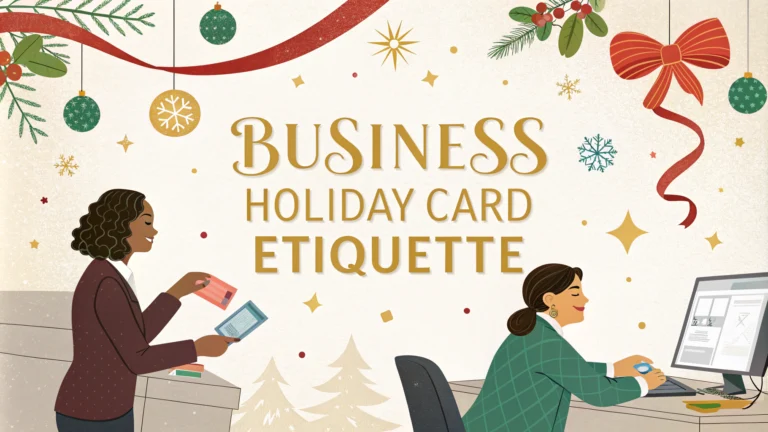Sending business holiday cards remains one of the most effective ways to strengthen professional relationships and show appreciation to clients, employees, and partners.
Timing Your Business Holiday Cards
Business holiday cards should ideally be mailed between late November and early December to ensure they arrive before the holiday rush.
For international recipients, send cards at least three weeks before December 25th to account for longer delivery times.
Selecting Appropriate Cards
- Choose non-religious, secular designs unless you’re certain of the recipient’s beliefs
- Select high-quality cardstock that reflects your business standards
- Consider custom designs featuring your company logo or branding
- Opt for professional imagery like winter scenes, cityscapes, or abstract designs
Writing Professional Holiday Messages
Keep messages warm but professional, avoiding overly personal or religious content.
Addressing and Signing
- Address cards to specific individuals when possible
- Include spouses’ names for small business clients
- Hand-sign each card to add a personal touch
- Use blue ink for signatures to distinguish from printed text
Digital Holiday Greetings
Electronic cards can be appropriate for environmentally conscious businesses or companies with primarily digital relationships.
- Send from a professional email address
- Test all links and animations before sending
- Include alt text for accessibility
- Optimize for mobile viewing
Common Mistakes to Avoid
- Sending cards too late in the season
- Using generic mailing labels instead of handwritten addresses
- Forgetting to update contact lists
- Including promotional materials or sales pitches
Track your holiday card program by maintaining a spreadsheet of recipients, send dates, and any returned mail to improve next year’s process.
- ✓ Update mailing list by October
- ✓ Order cards by early November
- ✓ Begin addressing by mid-November
- ✓ Mail domestic cards by December 1st
- ✓ Mail international cards by November 25th
Additional Card-Sending Tips
- Keep a supply of extra cards for last-minute additions
- Consider time zones when sending digital greetings
- Save examples of well-received messages for future reference
- Document any returned cards to update your database
Business Holiday Card Etiquette
Cultural Considerations
- Research cultural norms for international recipients
- Be mindful of different holiday celebrations
- Consider neutral “New Year” messages for global audiences
Professional Boundaries
- Maintain appropriate formality in greetings
- Avoid jokes or casual language
- Skip political or controversial themes
Measuring Impact
Track the effectiveness of your holiday card program through:
- Response rates and reciprocal greetings
- Client retention metrics
- Feedback from recipients
- Social media mentions or engagement
Conclusion
Business holiday cards remain a valuable tool for maintaining professional relationships and expressing gratitude. Success lies in careful planning, appropriate timing, and attention to professional etiquette. Whether choosing traditional paper cards or digital alternatives, focus on creating genuine connections while maintaining business standards.
Remember that holiday cards are an investment in relationship building, not just a seasonal task. Plan accordingly and use this opportunity to strengthen your business networks for the year ahead.
FAQs
- When is the best time to send business holiday cards?
Send business holiday cards between late November and mid-December, ideally arriving at least one week before December 25th. For international clients, send them earlier to account for longer delivery times. - Should I send religious or secular holiday cards to business contacts?
Choose secular, non-denominational holiday cards for business relationships unless you’re certain of the recipient’s religious preferences. “Season’s Greetings” or “Happy Holidays” are safe, professional options. - Is it appropriate to include business promotional material in holiday cards?
No, holiday cards should focus on expressing gratitude and seasonal wishes. Including promotional materials or sales pitches can appear unprofessional and diminish the sincerity of your greeting. - Should holiday cards be signed by hand or printed?
Whenever possible, cards should be hand-signed to add a personal touch. For large organizations, at minimum the signature of a department head or executive should be handwritten, even if the message is printed. - Is it acceptable to send electronic holiday cards to business contacts?
While electronic cards are becoming more common, traditional paper cards are still preferred for important business relationships. E-cards are acceptable for casual business contacts or environmentally conscious organizations. - What should I write in a business holiday card?
Keep messages professional and concise, focusing on appreciation for the business relationship. Include a genuine holiday wish and, if appropriate, a brief mention of looking forward to continued collaboration in the new year. - How should I address business holiday cards to companies with multiple contacts?
Send individual cards to key contacts within the organization. For general office staff, one card addressed to “The Team at [Company Name]” is appropriate. - What if I accidentally omit someone from the holiday card list?
If you discover the oversight before the holiday season ends, send a card immediately with a brief apology. If discovered later, wait until the next appropriate occasion to maintain correspondence. - Should I send cards to former clients or business contacts?
Yes, sending cards to former clients can maintain positive relationships and keep communication channels open for future opportunities, provided the relationship ended on good terms. - Is it necessary to respond to received business holiday cards?
While not mandatory, acknowledging received cards with a brief thank-you email or mention in your next business interaction is courteous, especially for important business relationships.







